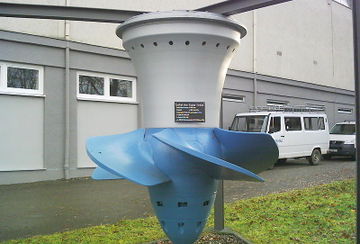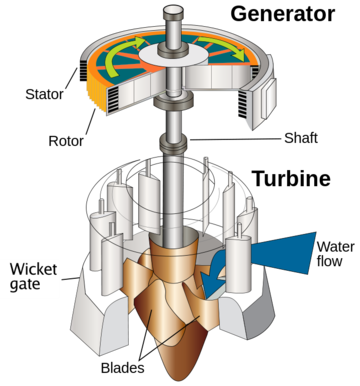Kaplan turbine

A Kaplan turbine is a type of propeller hydro turbine (specifically a reaction turbine) used in hydroelectric plants. Water flows both in and out of Kaplan turbines along its rotational axis (axial flow). What makes Kaplan turbines special is the blades can change their angle on demand to maintain maximum efficiency for different flow rates of water.[2] Water flowing through a Kaplan turbine loses pressure, this means that a Kaplan turbine is a reaction turbine (similar to a Francis turbine).
The area that water can enter these turbines is large, equal to the entire area that the blades occupy. The large area of Kaplan turbines make them most useful where large volumes of water flow, and can be used even in dams with relatively low head. This is especially important as previous to the development of the Kaplan turbine, most turbines were only suitable for large heads of water. Viktor Kaplan designed this turbine off of the design of ship propellers, and because of that they work essentially in the opposite way as propellers.[3]
Design

These turbines must be designed so that they allow large amounts of water to flow through them without damaging them. The way that Kaplan turbines are designed is slightly different from other turbines. This turbine is much simpler. There is a flow passage that introduces water in the radial direction, and specialized guide vanes - stationary blades that direct the water abruptly so that it enters the turbine in the axial direction. The turbine itself is equipped with several rotor blades attached directly to the central shaft of the turbine.[2] These blades are attached with movable joints so that the angle can be altered, ensuring that there is maximum efficiency for any given flow rate and water head.[3]
It is important to note that the blades of this turbine are not flat, instead they twist slightly because the outer part of the blade moves more quickly than the inner part.[2]
Operation
The way that water is moved through a Kaplan turbine is slightly different from other turbines. First, the water is directed towards the turbine radially, approaching from the side. This is done because the generator is usually located somewhere along the axis of the turbines rotation, so if the generator was located here it would get wet.[2] Instead, guide vanes rapidly take the water through a ninety degree turn so that it hits the blades axially. As well as redirecting the water, these vanes are aligned to give the water an appropriate amount of "swirl".[3]
The water then moves down over the blades of the propeller, turning it with the "swirl" of the water. This type of turbine is therefore known as a reaction turbine as the reaction force from the push of the water on the propeller forces the propeller to move. The water leaves the turbine axially.
For more information on the operation of Kaplan turbines, click here.
For Further Reading
- Francis turbine
- Pelton turbine
- Turgo turbine
- Hydroelectric facility
- Hydroelectric dam
- Primary energy
- Or explore a random page
References
- ↑ Wikimedia Commons. (August 25, 2015). Kaplan Turbine [Online]. Available: https://upload.wikimedia.org/wikipedia/commons/d/d0/Kaplan-Turbine-2007.jpg
- ↑ 2.0 2.1 2.2 2.3 G. Boyle. Renewable Energy: Power for a Sustainable Future, 2nd ed. Oxford, UK: Oxford University Press, 2004.
- ↑ 3.0 3.1 3.2 BrightHub Engineering. (August 25, 2015). Kaplan Turbines [Online]. Available: http://www.brighthubengineering.com/fluid-mechanics-hydraulics/27426-hydraulic-turbines-kaplan-turbine/
- ↑ By U.S. Army Corps of Engineers, This file was derived from: Water turbine (en).svg:, Public Domain, https://commons.wikimedia.org/w/index.php?curid=18581340

